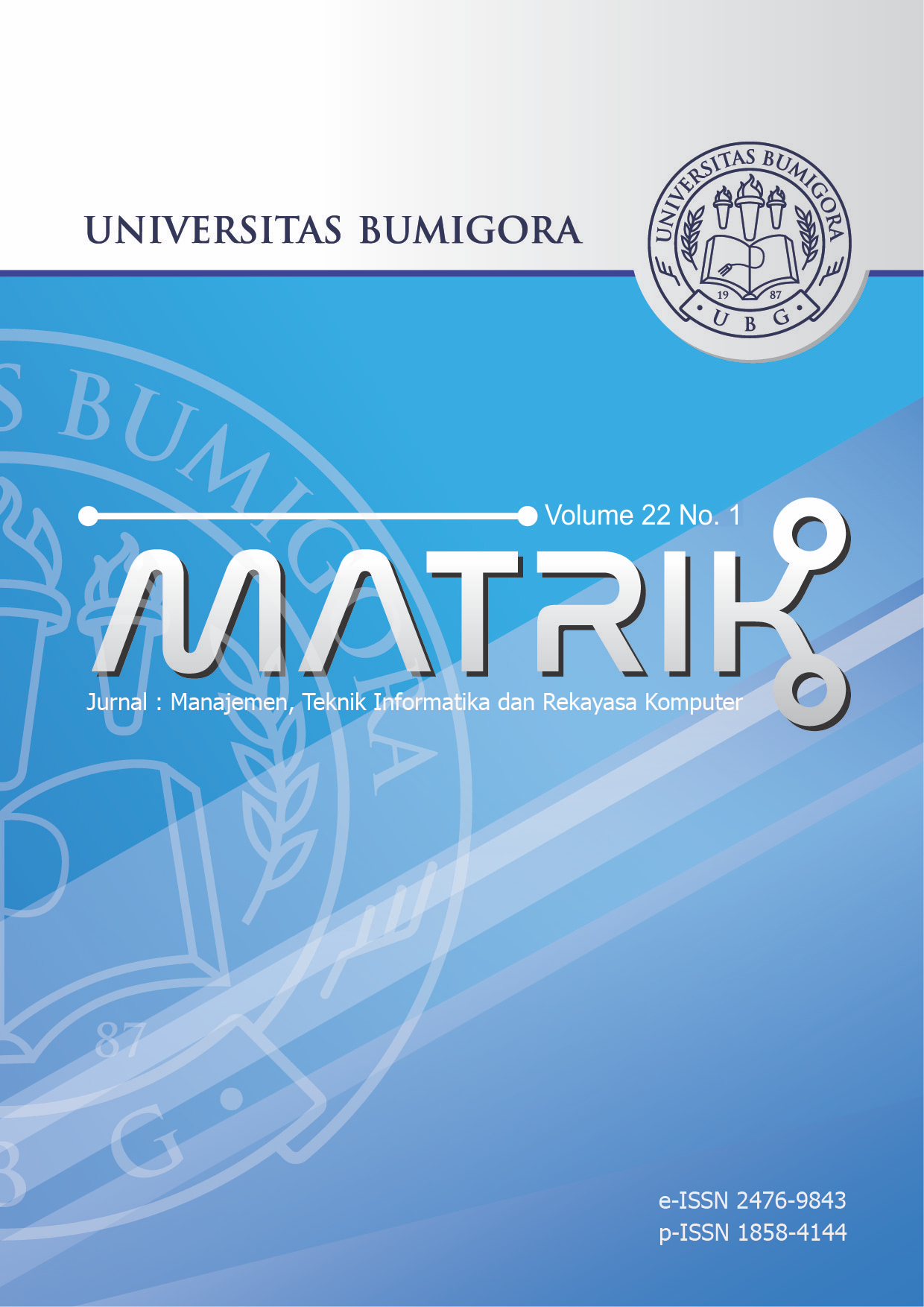User Interface and Exprience Gamification-Based E-Learning with Design Science Research Methodology
DOI:
https://doi.org/10.30812/matrik.v22i1.2427Keywords:
E-Learning, Gamification, User Interface, User Experience, User Experience QuestionnaireAbstract
In 2020, the Islamic Elementary Teacher Working Group (KKG MI) held an E-Learning Training for Islamic Elementary School Teachers in DKI Jakarta about one of the gamification applications, Quizizz. According to observation, many teachers are still perplexed when utilizing the Quizizz program. This is due to the application’s design and different functionalities, which still appear complicated to some teachers who aren’t used to using it. The existing gamification application is also considered not to meet the learning needs at Islamic elementary schools in Jakarta. This study intends to analyze and design User Interface (UI) and User Experience (UX) designs for gamification-based e-learning applications as solutions to the problems found. Data collection begins with an observation and also a literature study, questionnaires, and interviews. For the design, Design Science Research Methodology (DSRM) is used, which consists of six stages: Problem Identification & Motivation, Define the Objective for a Solution, Design & Development, Demonstration, Evaluation and Communication. The results of the evaluation of the gamification-based e-learning design designed with the User Experience Questionnaire (UEQ) and Task Success show that the e-learning design is considered attractive and users can interact with e-learning effectively and easily.
Downloads
References
Students,†International Journal of Emerging Technologies in Learning, vol. 13, no. 12, pp. 157–176, 2018.
[2] Y. Zou, L. Shen, and S. Dadparvar, “The Influence of E-Learning Behavior on Students’ Learning Performance of Disaster
Emergency Knowledge,†International Journal of Emerging Technologies in Learning (iJET), vol. 17, no. 01, pp. 49–59, jan
2022. [Online]. Available: https://online-journals.org/index.php/i-jet/article/view/28475
[3] A. Thoo, A. Thoo, S. Hang, Y. Lee, and L. Tan, “Students’ Satisfaction Using E-Learning as a Supplementary Tool,†International
Journal of Emerging Technologies in Learning (iJET), vol. 16, no. 15, pp. 16–30, 2021.
[4] A. Y. Alqahtani and A. A. Rajkhan, “E-Learning Critical Success Factors During The Covid-19 Pandemic: A Comprehensive
Analysis of E-Learning Managerial perspectives,†Education Sciences, vol. 10, no. 9, pp. 1–16, 2020.
[5] H. A. Yamani, “A Conceptual Framework for Integrating Gamification in E-Learning Systems Based on Instructional Design
Model,†International Journal of Emerging Technologies in Learning (iJET), vol. 16, no. 04, pp. 14–33, feb 2021. [Online].
Available: https://online-journals.org/index.php/i-jet/article/view/15693
[6] D. Orhan G¨oks¨un and G. G¨ursoy, “Comparing Success and Engagement in Gamified Learning Experiences Via Kahoot and
Quizizz,†in Computers and Education, vol. 135, no. January. Elsevier, 2019, pp. 15–29.
[7] W. T. Nakamura, L. C. Marques, L. Rivero, E. H. T. De Oliveira, and T. Conte, “Are Scale-Based Techniques Enough for
Learners to Convey Their UX when Using a Learning Management System?†Revista Brasileira de Inform´atica na Educac¸ ˜ao,
vol. 27, no. 01, pp. 104–131, jan 2019. [Online]. Available: http://www.br-ie.org/pub/index.php/rbie/article/view/7788
[8] Y. M. Lim, A. Ayesh, and K. N. Chee, “Socio-Demographic Differences in The Perceptions of Learning Management System
(Lms) Design,†International Journal of Software Engineering & Applications, vol. 4, no. 5, pp. 15–35, 2013.
[9] T. Phunkaew, C. Phandan, and C. Wongwatkit, “Design and Evaluation of Interactive Learning Story and User Interface Prototyping
for Mobile Responsive Learning Application,†in Proceedings of 2019 4th International Conference on Information
Technology: Encompassing Intelligent Technology and Innovation Towards the New Era of Human Life, InCIT 2019. IEEE,
2019, pp. 132–137.
[10] F. A. Bachtiar, F. Pradana, B. Priyambadha, and D. I. Bastari, “CoMa: Development of Gamification-Based E-Learning,†in
2018 10th International Conference on Information Technology and Electrical Engineering (ICITEE). IEEE, jul 2018, pp.
1–6. [Online]. Available: https://ieeexplore.ieee.org/document/8534875/
[11] H. Naufal Irfan and S. Hansun, “Pembangunan Aplikasi Latihan Soal IPA SD dengan Gamifikasi dan Mersenne Twister,†Jurnal
Teknologi Informasi dan Ilmu Komputer (JTIIK), vol. 7, no. 1, pp. 87–98, 2020.
[12] A. C. T. Klock, I. Gasparini, and M. S. Pimenta, “User-Centered Gamification for E-Learning Systems: A Quantitative and
Qualitative Analysis of its Application,†Interacting with Computers, vol. 31, no. 5, pp. 425–445, 2020.
[13] I. Suprianto, F. Pradana, and F. Abdurrachman Bachtiar, “Pengembangan Aplikasi E-Learning dengan Menerapkan Metode
Gamification,†Jurnal Pengembangan Teknologi Informasi dan Ilmu Komputer, vol. 3, no. 2, pp. 1716–1724, 2019.
[14] Sugiyono, Metode Penelitian Kuantitatif, Kualitatif dan R & D , 19th ed. Bandung: Alfabeta, 2014, 2014.
[15] T. Tullis and B. Albert, Measuring The User Experience. Elsevier, jul 2013. [Online]. Available: https:
//linkinghub.elsevier.com/retrieve/pii/C20110000169
[16] A. Apriani, H. Zakiyudin, and K. Marzuki, “Penerapan Algoritma Cosine Similarity dan Pembobotan TF-IDF System Penerimaan Mahasiswa Baru pada Kampus Swasta,†Jurnal Bumigora Information Technology (BITe), vol. 3, no. 1, pp. 19–27, 2021.
Downloads
Published
Issue
Section
How to Cite
Similar Articles
- Khairunnisak Nur Isnaini, Didit Suhartono, Evaluation of Basic Principles of Information Security at University Using COBIT 5 , MATRIK : Jurnal Manajemen, Teknik Informatika dan Rekayasa Komputer: Vol. 21 No. 2 (2022)
- Rahmaddeni Rahmaddeni, M. Teguh Wicaksono, Denok Wulandari, Agustriono Agustriono, Sang Adji Ibrahim, Enhancing Multiple Linear Regression with Stacking Ensemble for Dissolved Oxygen Estimation , MATRIK : Jurnal Manajemen, Teknik Informatika dan Rekayasa Komputer: Vol. 24 No. 1 (2024)
- Pradita Dwi Rahman, Heri Wijayanto, Royana Afwani, Wirarama Wesdawara, Ahmad Zafrullah Mardiansyah, Blockchain-Based TraditionalWeaving Certification and Elliptic Curve Digital Signature , MATRIK : Jurnal Manajemen, Teknik Informatika dan Rekayasa Komputer: Vol. 24 No. 1 (2024)
- Anthony Anggrawan, Analisis Deskriptif Hasil Belajar Pembelajaran Tatap Muka dan Pembelajaran Online Menurut Gaya Belajar Mahasiswa , MATRIK : Jurnal Manajemen, Teknik Informatika dan Rekayasa Komputer: Vol. 18 No. 2 (2019)
- Anugerah Bagus Wijaya, Suliswaningsih Suliswaningsih, Argiyan Dwi Pritama, Meningkatkan Rasa Nasionalisme Siswa Melalui Game Base Learning , MATRIK : Jurnal Manajemen, Teknik Informatika dan Rekayasa Komputer: Vol. 19 No. 1 (2019)
- Angelina Ervina Jeanette Egeten, PENGARUH PEMBELAJARAN E-LEARNING DAN KEBIASAAN BELAJAR TERHADAP PENINGKATAN KOMPETENSI MAHASISWA PASCASARJANA PADA UNIVERSITAS BINA NUSANTARA , MATRIK : Jurnal Manajemen, Teknik Informatika dan Rekayasa Komputer: Vol. 16 No. 2 (2017)
- Tri Oktarina, Media Pembelajaran Online untuk Mendukung Belajar Pada Stebis Islam Darussalam , MATRIK : Jurnal Manajemen, Teknik Informatika dan Rekayasa Komputer: Vol. 19 No. 2 (2020)
- Melinda Melinda, Zharifah Muthiah, Fitri Arnia, Elizar Elizar, Muhammad Irhmasyah, Image Data Acquisition and Classification of Vannamei Shrimp Cultivation Results Based on Deep Learning , MATRIK : Jurnal Manajemen, Teknik Informatika dan Rekayasa Komputer: Vol. 23 No. 3 (2024)
- Lusiana Efrizoni, Sarjon Defit, Muhammad Tajuddin, Anthony Anggrawan, Komparasi Ekstraksi Fitur dalam Klasifikasi Teks Multilabel Menggunakan Algoritma Machine Learning , MATRIK : Jurnal Manajemen, Teknik Informatika dan Rekayasa Komputer: Vol. 21 No. 3 (2022)
- Arfiani Nur Khusna, Krisvan Patra Delasano, Dimas Chaerul Ekty Saputra, Penerapan User-Based Collaborative Filtering Algorithm , MATRIK : Jurnal Manajemen, Teknik Informatika dan Rekayasa Komputer: Vol. 20 No. 2 (2021)
You may also start an advanced similarity search for this article.
Most read articles by the same author(s)
- Luh Kesuma Wardhani, Nenny Anggraini, Nashrul Hakiem, M. Tabah Rosyadi, Amin Rois, IoT-based Integrated System Portable Prayer Mat and DailyWorship Monitoring System , MATRIK : Jurnal Manajemen, Teknik Informatika dan Rekayasa Komputer: Vol. 22 No. 3 (2023)
- Muhamad Nur Gunawan, Titi Farhanah, Siti Ummi Masruroh, Ahmad Mukhlis Jundulloh, Nafdik Zaydan Raushanfikar, Rona Nisa Sofia Amriza, Accuracy of K-Nearest Neighbors Algorithm Classification For Archiving Research Publications , MATRIK : Jurnal Manajemen, Teknik Informatika dan Rekayasa Komputer: Vol. 23 No. 3 (2024)
- Siti Ummi Masruroh, Andrew Fiade, Muhammad Ikhsan Tanggok, Rizka Amalia Putri, Luigi Ajeng Pratiwi, Convolutional Neural Network for Colorization of Black and White Photos , MATRIK : Jurnal Manajemen, Teknik Informatika dan Rekayasa Komputer: Vol. 22 No. 2 (2023)


.png)












